Some of the links in this post may be affiliate links.
What exactly does it mean when you hear that you are overwatering a plant? What happens when you overwater a plant? This post will discuss the VERY misunderstood topic of properly watering a plant.
You will also learn about signs of underwatering plants as well as signs of overwatering plants. And I actually hate the term overwatering, so I will give you my take on what it means to most people, but also what it really means.

I believe the term “overwatering” is a very dangerous term and this post will aim to demystify the topic once and for all.
First let’s get into some symptoms of both underwatering and overwatering your houseplants.
It is important to understand BOTH. It can be a confusing topic because the signs can be the same!
Table of Contents
Signs of Under Watering Houseplants
There are many different indications that you can look for that will tell you if you are underwatering your houseplant.
One indication of underwatering is that the lower leaves of your plant will turn yellow. In more extreme cases, if the plant continues to be very dry, the entire plant will wilt and collapse.
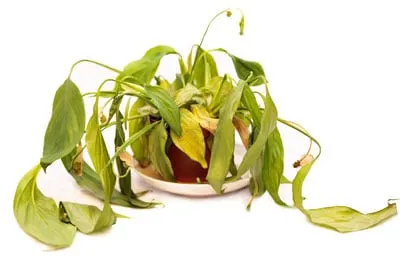
For anyone that has a peace lily (Spathiphllym), you’ll know that it will quickly tell you that it needs a drink of water! Give it a good drink of water, drain the excess away, and your plant will recover quickly.
If you notice that your plant has wilted, but the soil is still moist and you haven’t watered it in a while, then clearly underwatering is not your issue.
Keep reading to learn about other things that may have gone wrong. I’ll get into overwatering later.
Underwatered plants also typically can have edges of leaves that have turned brown and are crispy. Crispy and brown edges can also be due to other things such as over-fertilizing.
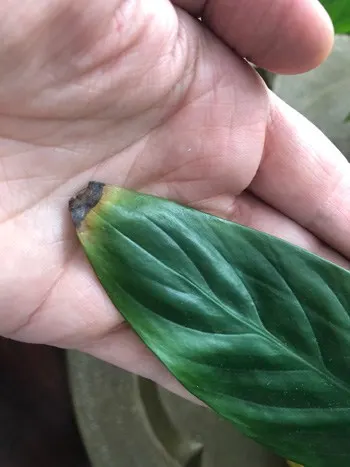
There are a few things that can cause brown leaf tips on your houseplants. If you continually let your soil dry out for extended periods of time, this will surely happen.
You can also get brown, crispy leaf tips if your watering practices are not up to par.
If you are not watering your houseplant thoroughly, the plant will use up all the water that it can, and when there is no water left to travel to the tips of the leaves, they will not have the moisture they need, and the tips will turn brown.
If you are not throughly watering the potting mix of your houseplant until the water drains out of the drainage hole in your pot, it may result in dry pockets of soil.
Assuming that your houseplant has the correct combination of light, potting mix type, and well drained soil, you should always be watering thoroughly and completely moistening the potting mix.
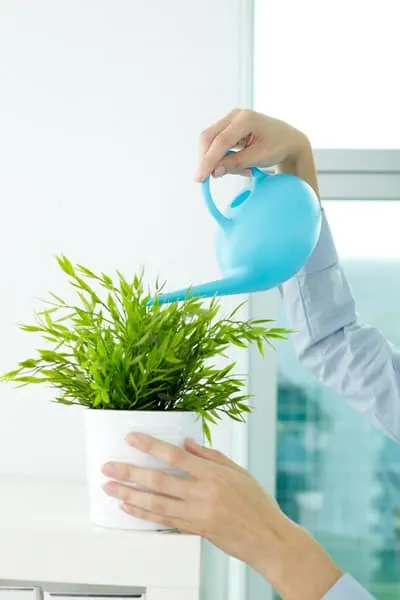
If you are doing what I described above, and you are still getting dry tips, it could be that your houseplant is very potbound and thus not able to use water as well as it should be.
In that case, you should repot your plant. Read my blog post on how to repot a plant that is rootbound for more information.
Once a plant leaf turns brown, there is really nothing that you can do except simply cut off the brown areas. It will never turn green again. What you can do though is to remedy your cultural practices to prevent further damage to your plant.
How to Revive a Plant That Has Dried Out
If your houseplant has dried out severely, one thing you will probably notice is that when you do water it, the water will very quickly start to rush out of the drainage hole and will not seem to moisten the potting mix much.
You may also see that the soil has pulled away from the perimeter of the pot. Potting soil that has dried out severely may take a little work to moisten it up again, depending on the composition of the potting mix.
If you can move your plant to a sink, move it there and water it repeatedly until you are sure that the soil is thoroughly moistened.
It may take several times in order to accomplish this, but it is very important! If you don’t do this, your plant may suffer severe harm and even die.
Signs of Over Watering Houseplants
There are many signs that you are overwatering your houseplant. One of the leading indicators for severe cases is that your plant will be wilted despite the soil being moist.
This means that your plant has gotten to the point where the roots have rotted and the plant is starting to wilt as a result.
Another indication can be brown leaves, which you will also get if your plant is too dry. However the difference is that your leaves will be limp and mushy, instead of dry and crispy, if you have overwatered.
Other indications that you have overwatered are the following: yellowing and dropping leaves, including newer leaves and not just the old ones.
Stunted growth can also be a result of overwatering, especially when it is found in combination with the above symptoms.
Do you have mushrooms growing on your soil? This is a very good indication that your soil is staying too wet! Otherwise the fungi will not be able to survive and grow.
Finally, if you take your plant out of its pot and you notice mushy roots, and even a sour, rancid odor, this means that your roots have rotted from staying wet for too long.
Saving an Overwatered Plant
First of all, you should NOT fertilize a plant that has been overwatered! A plant that is in stress should never be fertilized. You will actually make the situation worse.
If your plant has symptoms of “overwatering”, such as the whole plant starting to wilt despite the soil being moist, I would recommend the following steps:
- If you have your plant in a dim location, immediately move it to a brighter location, but that is still appropriate light for your particular plant.
- Don’t water again until the soil has dried out completely.
- Your plant should slowly recover if the damage caused by root rot is not severe.
If you are afraid that your plant won’t make it, you can always take some cuttings to propagate the plant and start from scratch!
How to Water Plants and How Not to Overwater
This all comes down to proper houseplant culture! So how can you make sure that your plant is not overwatered?
First of all, I encourage everyone to thoroughly water your houseplants. Water until all of the soil is thoroughly moistened and running out of the drainage hole. Then discard any extra water.
All this is very critical in order to have a healthy houseplant!
Overwatering a houseplant does NOT mean that you are adding too much water at a single watering! The goal is to thoroughly moisten the soil and ensure that any excess is drained away.
This is the proper way to water. But if some other fundamental things are not met, your plant will suffer.
What are these fundamental items that I’m referring to?
Make sure your plant has the correct light! This is number 1. If you shove your houseplant in a dark corner of the house, it will minimize growth, and therefore the plant will not be able to use water up like it should.
The soil can potentially stay wet for a very long time if your plant is kept too dark.
Ensuring that your plant is situated in appropriate light (meaning very close to a window!) is critical.
Use a well draining potting soil. I personally love using Miracle-Gro potting soils. Even for succulents, I like the Miracle Gro Cactus, Palm and Citrus mix. Not all potting mixes are created equal.
If you have any that are not draining as well as you’d like, I like to mix in a good amount of either perlite or pumice. I use both perlite and pumice for different cases.
I tend to add some additional perlite to any potting mix for tropicals to increase porosity in the soil and increase drainage. I tend to use pumice for succulents. Either one will do the job.
The bottom line is that you want your soil to dry out to some extent between watering.
By ensuring that your plant is receiving proper light, has a well draining potting mix, and an appropriately sized pot, you should be good to go!
These ideal conditions, in combination with proper watering, is the “secret” to make your houseplants thrive!

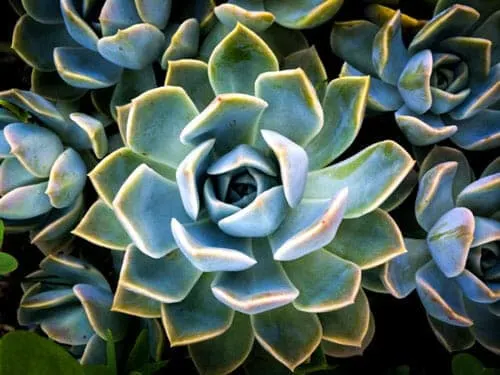
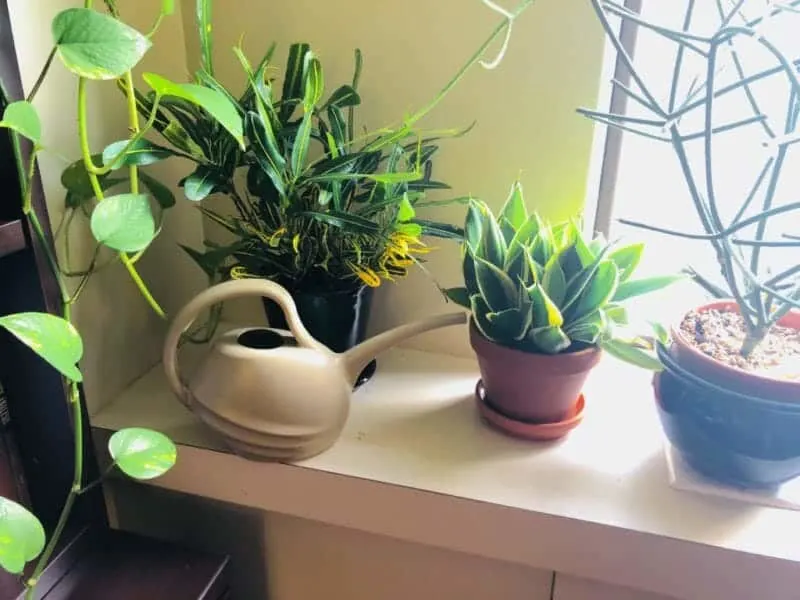
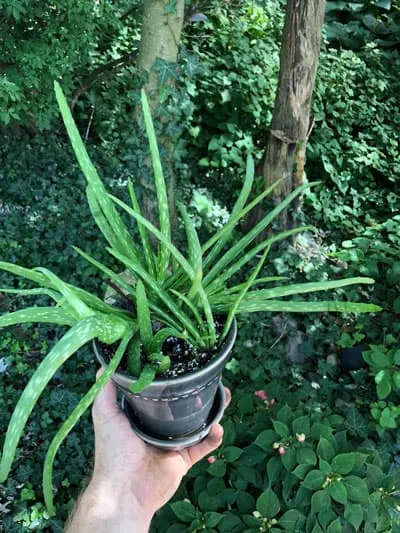

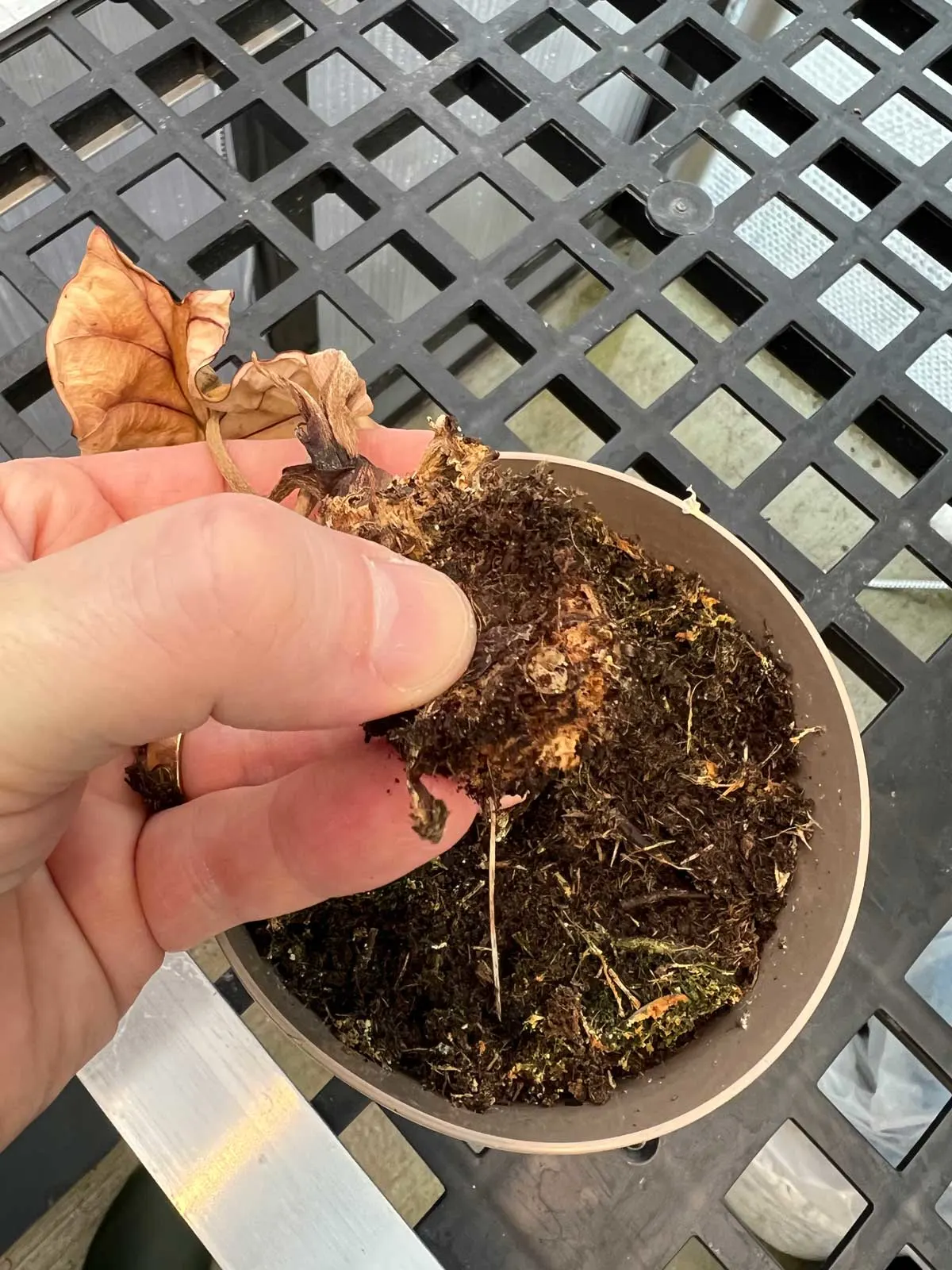
Bebe
Monday 15th of January 2024
I had the same problem with Miracle Grow Potting soil. I opened the bag and there were gnats. The company must know there is a problem because when I was at Ace Hardware I saw they now have a potting soil less prone to gnats. Here's the description. "Grow amazing indoor container plants with Miracle-Gro® Indoor Potting Mix. It has been blended for a wide variety of container plants and is designed to be less prone to gnats*. This mix has an easy-to-water formula that helps the soil easily re-wet while feeding for up to 6 months." Also, have ordered from Amazon a product "Mosquito Bits" which will help control gnats. Haven't tried it yet but arriving today.
Raffaele
Thursday 25th of January 2024
Thanks for sharing! I hope you can get the gnats under control.
Sheri
Wednesday 27th of December 2023
What a fantastic post thank you! There’s only one thing I don’t understand is why you use Miracle-Gro potting mix? This has got to be the worst potting mix I’ve seen in person. My Mom uses it and it stays wet constantly. You can feel it when you put your hand in the bag. It also over fertilizes the plant, so any novice coming in may think they should fertilize. I also have seen and heard about Miracl-Gro having really nasty infestations. My Mom has a severe issue now with fungus gnats and I know it has to do with over wet soil.
I would be careful recommending this product.
Raffaele
Thursday 28th of December 2023
This is a really old blog post, and I always amend that soil with perlite, pumice, or other materials. I've actually never had many issues with fungus gnats. Probably because I allow the soil to dry out a good amount (at least the top inch or so, depending on the plant). I use a variety of different mixes, but I still use this sometimes and it works fine for me because I mix in other materials to improve drainage. Hope this helps!
Bev
Wednesday 25th of October 2023
Love your blog. My peace lily's leaves are green but are curling under rather while staying green rather than being flat and green. I am not sure what I am doing wrong.
Raffaele
Wednesday 25th of October 2023
Glad you enjoy my blog Bev! How long have you had your plant? Are the tips turning brown at all? Describe your temperature, light, and watering for me?
iris
Monday 2nd of October 2023
i really enjoy your blogs. They are so helpful. I have been reading about the peace lilies, I went to my front porch to bring mine in for the winter and I noticed that most of the leaves have turned pale green, so I sat down, and I gave it a good trimming but I don’t know if it’s gonna survive or not, the leaves, were not droopy, but they changed to a lighter green .Can you please help me with this?
Raffaele
Tuesday 3rd of October 2023
So glad that you enjoy my blog Iris! What kind of light is it getting on the front porch? Any direct sun? If so, how many hours? Have you been fertilizing? What are temperatures like?
Hannah
Sunday 30th of July 2023
Amazing post! Thank you so much for all the tips. All the info was succinct and incredibly helpful. Really appreciate it and look forward to reading your other posts as well🌿🌿🌿
Raffaele
Sunday 30th of July 2023
So glad you enjoyed the post Hannah :-)